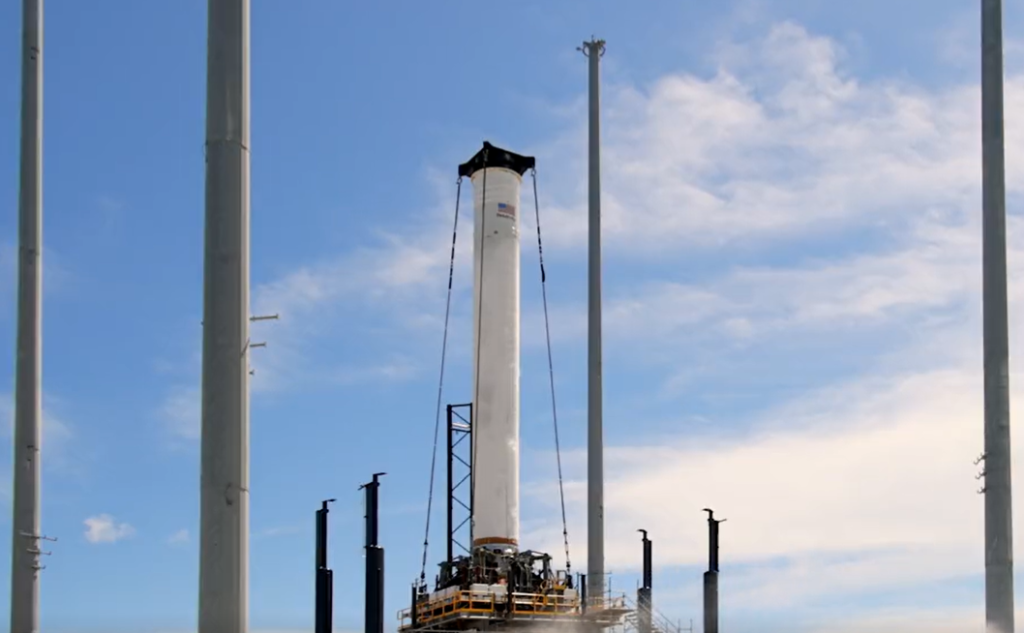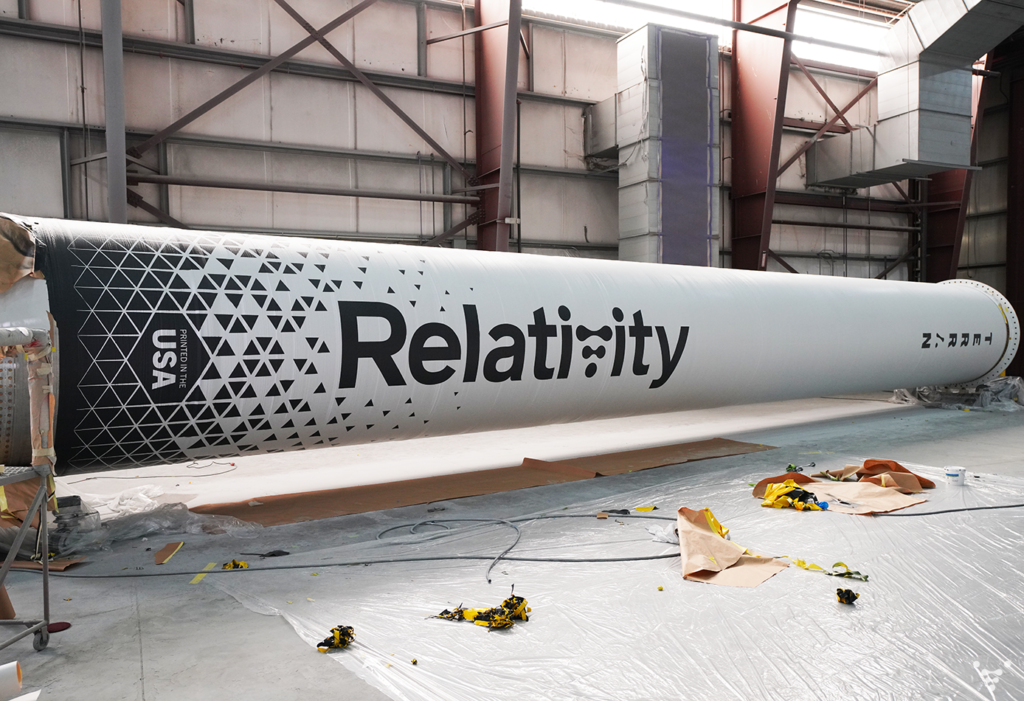
New Updates On Both Terran 1 & R
Relativity Space has been making lightning fast progress as they continue to work towards the first launch of Terran 1 and the development of Terran R. In the last few weeks alone the company has managed to complete multiple static fires along with additional tests. All of which in preparation for the first ever orbital test flight of Terran 1 and a 3D printed rocket.
Just a few days ago Relativity showed off a full duration static fire of the mounted Terran 1 first stage. For a while now the company has been aiming for a summer launch and at this rate, it’s very possible. Not only is Terran 1 making great progress, but so is its bigger brother Terran R. Tim Ellis recently shared some insights to the rocket’s engine development.
Relativity is trying to completely change how rockets are manufactured and created. While this process comes with some added risks, if successful, it could change how companies and agencies around the world create rockets and space technology. Here I will go more in-depth into the upcoming Terran 1 launch, Aeon R engine progress, and more.
Recent Updates

Some of the most significant news came in the form of Terran 1 updates as the company closes in on the first launch. Specifically, just two days ago on the 22nd, Relativity Space tweeted saying, “Another 1st in the books! Completed a full duration 20-second hot fire for all nine Aeon 1 engines on Stage 1 of Terran 1, the world’s first 3D printed rocket (w/ entirely 3D printed engines!) This tweet included a video showing a few different angles of the static fire which appeared to go very well. In addition, CEO Tim Ellis tweeted on the same day mentioning, “FULL DURATION 20 second stage test complete! Reviewing data and if all looks good, on to full flight duration test before LAUNCH. We are the first company to ever do this on launch mount at Cape Canaveral, and on track to be the first oxygen/methane rocket launched to orbit.” This tweet included a different video that was a bit longer and highlighted a close up angle of the engines firing.
A lot of these tests are especially impressive because of the engines design and its future applications. Relativity’s Aeon engines are designed, assembled and tested in house. Except for the second-stage nozzle extension, each of Terran 1’s 10 engines is based on a common design, enabling simplified and repeatable manufacturing and acceptance testing. Aeon engines are fueled by liquid natural gas and liquid oxygen and operate using the gas generator engine cycle. Each engine uses two turbopump assemblies for thrust and mixture ratio control: one for liquid natural gas and one for liquid oxygen. The thrust chamber is regeneratively cooled with liquid natural gas, which is then injected into the main combustion chamber and burned with liquid oxygen to produce the required thrust. The upcoming launch of Terran 1 will be a great test for these engines and their performance.
While Terran 1 has been making impressive progress in a lot of ways, it’s not alone. For years now Relativity has also been working to develop Terran R, a much bigger and more powerful rocket of the future. Recently, on August 15th, Tim Ellis tweeted pointing out, “Stargate tech already showing improvements to dev speed for Aeon R hardware. Bigger engines are normally much harder, additive helping overcome these challenges.” In the future, 7 Aeon R engines are expected to power the first stage of Terran R and a single Aeon Vac for the upper stage. This engine development is a key step in the future of this launch vehicle. With the goal of launching over 20,000 kilograms into low Earth orbit and being reusable, the engines will need to be both powerful and reliable. In the replies to the Tweet I mentioned just before, someone asked if Relativity was already utilizing Stargate for Aeon R operations. Tim Ellis responded by saying, “Yes for quite a bit of it.” Relativity’s large format, proprietary 3D printing process, known as Stargate, is used to produce primary and secondary structures for Terran 1 from a proprietary aluminum alloy – with printing, inspection, and the little post-processing required occurring all in a single print cell. The fact that Relativity is already using this technology on key components of Terran R is a very good sign. The final update on this rocket came in the form of another tweet highlighting the Aeon R engine. On August 17th Tim Ellis tweeted mentioning, “These are significant efficiency and thrust improvements and will increase payload to orbit for Terran 1 flight 2. Team rocking it! Simultaneously making progress on Aeon R still on track to start testing this year in Stennis.” This suggests that in only a few months we could see Aeon R fire.
GLHF

Now that we know more about Relativity’s progress on both Terran 1 and R, we can take a closer look at the most significant test in the company’s history coming up. As of right now, Relativity is scheduled for its first launch of Terran 1, called “GLHF” (Good Luck, Have Fun), from Launch Complex 16 (LC-16) in Cape Canaveral this summer. This launch of Terran 1 is the first orbital attempt by Relativity and will not include a customer payload. As a two-stage, 110ft. tall, 7.5 ft. wide, expendable rocket, Terran 1 is the largest 3D printed object to exist and to attempt orbital flight. Working towards its goal of being 95% 3D printed, Relativity’s first Terran 1 vehicle is 85% 3D printed by mass. Terran 1 has nine Aeon engines on its first stage, and one Aeon Vac on its second stage. Like its structure, all Relativity engines are entirely 3D printed, and use liquid oxygen (LOX) and liquid natural gas (LNG), which are not only one of the best for rocket propulsion, but also for reusability, and the easiest to eventually transition to methane on Mars. As one of the few LOX/LNG fueled rockets in the industry, Terran 1 is racing to be the first LOX/LNG rocket to fly.
One of the aspects that makes this launch so special is the manufacturing process. As partially mentioned prior, Relativity’s proprietary Factory of the Future centers on Stargate, the world’s largest metal 3D printers, that create Terran 1, the world’s first 3D printed rocket, and the first fully reusable, entirely 3D printed rocket, Terran R, from raw material to flight in 60 days. Relativity’s Stargate printers’ patented technology enables an entirely new value chain and innovative structural designs that make Terran 1 and Terran R possible. By developing its Factory of the Future and rockets together, Relativity accelerates its ability to improve design, production, quality, and speed. The company frequently highlights that for 60 years, aerospace manufacturing has relied on large factories, fixed tooling, complex supply chains, and extensive manual labor to build costly rockets comprised of 100,000 plus parts in 2 years or longer. This plays into the design of Terran 1 which provides a predictable and controlled launch environment allowing for simplified payload design requirements. Terran 1 can support both industry-standard and custom interfaces, using commercially available adapter and separation hardware in addition to mission-specific designs. Environmental control systems maintain clean, thermally controlled payload environments.
In order to accelerate innovation in the industry, Relativity is working to automate rocket manufacturing, vertically integrating intelligent robotics, software, and data-driven 3D printing technology. Incorporating Stargate, the world’s largest metal 3D printer with AI-driven controls, their Factory of the Future continuously optimizes production, resulting in greatly compounded quality and time improvements, lower costs, and product designs previously not possible. Relativity is an application-layer 3D printing company that is starting with rockets, and will try to extend its Factory of the Future to all of aerospace.
The upcoming launch will take place at LC-16. For years now, relativity has been constructing a launch facility on site LC-16 at Cape Canaveral Air Force Station (CCAFS) that will support initial test flights of Terran 1 and subsequent customer flights. The launch site, on the eastern end of CCAFS is ideal for supporting low- to mid-inclination (28.5° to 55°) orbits. Inclinations less than 28° and greater than 55° are also possible but may result in decreased mass to orbit performance due to dogleg trajectories. Before Relativity was competitively awarded the site in 2019, LC-16 was used by the US Air Force for Titan I, Titan II, and Pershing missile launches, and briefly by NASA for Gemini crew processing and static test firing of the Apollo Service Module’s propulsion engine. The site has had quite a lot of history and Relativity plans to use it for exciting launches.
Conclusion
Not long ago we watched Relativity transport the stages of Terran 1 to the launch complex. In this short period of time, the first stage has already been mounted and has completed a host of tests including a full duration static fire. With all the tests so far seeming to have gone very well, we can expect a launch very soon. We will have to wait and see how it progresses and the impact it has on the space industry.
